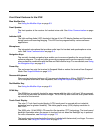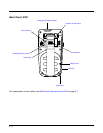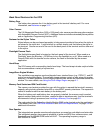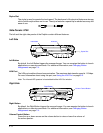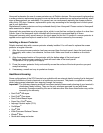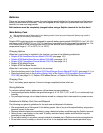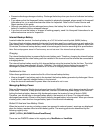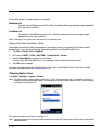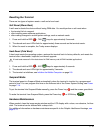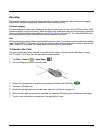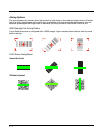
3 - 13
• Excessive discharge damages a battery. Recharge the battery when your terminal indicates low battery
power.
• If you observe that the Honeywell battery supplied is physically damaged, please send it to Honeywell
International Inc. or an authorized service center for inspection. Refer to the Product Service and
Repair section of this guide.
• Although your battery can be recharged many times, the battery life is limited. Replace it after the
battery is unable to hold an adequate charge.
• If you are not sure the battery or charger is working properly, send it to Honeywell International or an
authorized service center for inspection.
Internal Backup Battery
Located inside the terminal, the backup battery is a 3.6 Volt nickel metal hydride (NiMH) battery.
The internal backup battery prevents the terminal from being reset if you need to remove and replace the
main battery pack. It retains RAM data. If the terminal is left without the main battery pack for more than
30 minutes, the internal backup battery needs to be recharged to function according to its specifications.
Note: Data and programs stored in Flash memory are not lost even if the internal backup battery fails.
Charging
The internal backup battery is powered by the main battery pack. Therefore, charging the internal backup
battery requires that the main battery pack be installed in the terminal and the terminal be connected to
a charging device.
The internal backup battery must be fully charged before using the terminal for the first time. The initial
charge cycle takes approximately 8 hours. After that, if the internal backup battery becomes fully
discharged of power, it requires a minimum of 10 hours of charging time to function normally.
Guidelines for Use
Follow these guidelines to maximize the life of the internal backup battery:
• Keep a charged Li-ion battery pack in the terminal; the backup battery prematurely discharges if there
is not at least a partially charged battery in the terminal.
• Keep the terminal connected to power when the terminal is not in use.
Managing Battery Power
Data and files saved on Dolphin terminals may be stored in RAM memory, which does not persist through
a hard reset. Therefore, to help prevent data loss, maintain a continuous power supply to the terminal.
Letting the backup battery become fully discharged causes the terminal to lose all data in RAM.
Therefore, you should keep a charged battery pack in the terminal at all times. The internal battery
discharges prematurely if there is not at least a partially charged battery in the terminal. When you remove
a battery pack, insert another charged battery pack in the terminal immediately.
Default Critical and Low Battery Points
When the terminal is running on battery power (as opposed to external power), warnings are displayed
when the battery reaches critical and low battery points. The warning points are determined by the
following registry entry:
[HKEY_LOCAL_MACHINE\ControlPanel\Power]
There are two DWORD values in this registry entry: MedState and LowState.



